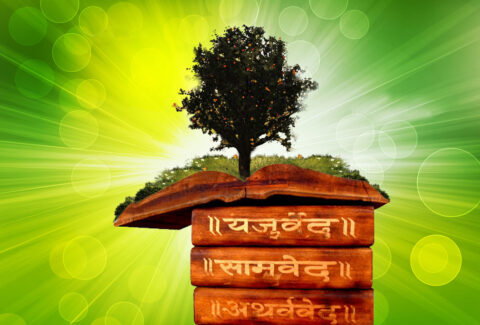
Ancient Indian traditions have always respected all elements of nature. The Yajurveda asserts that living beings are composed of panchabhutas, five elements- air, water, fire, Earth and ether. These collectively form the environment and provide conditions for sustaining human life. There is a hymn in the Vedas extolling the Earth as mother:
Samudra-Vasane Devi
Parvata-Stana-Mannddale
Vissnu-Patni Namas- Tubhyam
Paada-Sparsham Kssamasva-Me
Just as a mother gives birth and takes care of her child, the earth also carries the burden of mountains, rivers, oceans and living beings residing on it, and we should revere it always.
Indian traditions have always believed in living in harmony with nature, as evidenced by the daily rituals linked to nature. For instance, it has been proven that yajna creates a pure and medicinal atmosphere. It renews the brain cells, revitalises the skin, purifies blood and prevents growth of pathogenic organisms. Purification of the environment through the constituent electrons of the substances fumigated in the yajna is as obvious consequence of this process.
yet, we are blindly following models of development that are damaging the environment. Driven by incessant greed, humanity is treading a dangerous path, which will only lead to destruction. The solution lies in embracing change at the fundamental level. Our ancient literature provides a good deal of knowledge about each aspect of life. In the case of environmental conservation, we can learn a lot from our ancestors. All the four Vedas- the Rig, sama, Yajur and Atharva– recognise the importance of maintenance of seasons’ cycles that are likely to get altered due to climate change owing to inappropriate human actions. it is remarkable that the people in the Vedic times regarded nature and the environment in a holistic manner and revered each of its constituents and entities by carefully preserving them.
Our ancestors compared trees to human beings and gods. They prayed to Indra not to separate the trees from the forests as the sons from their fathers. Trees like the Banyan have great importance in Indian culture; bilva, kadamba, rudraksha, champaka and bakula too are worshipped. in the Maitrayani Samhita, the Earth has been described as Devajayani, adored by deities, and aushadhinam mulam, the source of all medicinal plants.
The fire and sun play the most significant role in the purification of the environment. animals and birds are part of nature and environment. The Vedic seers have mentioned about their characteristics and activities and have desired their welfare. Rig Vedic seers classify them in three groups- sky animals like birds, forest animals and animals in human habitation. All three types of living creatures have different environments and every living creature has an environment. There is a general emphasis in the Vedic texts that birds and animals should be protected.
Avatars of Vishnu like Matsya, Kurma, varaha and Narsimha signify the divine forms in such animals. The cobra is worshipped on the eve of Nag Panchami and cows are offered adoration during Balabhadra Puja. killing of certain animals and birds who acted as scanvengers by feeding on carcasses and filth was banned. The sages realised that pure water and air are roots of good health and happiness, hence they considered all these as gods. the wish to love a long and healthy life can be fulfilled only when the environment is unpolluted, clean and peaceful.
Unity in diversity is the message of Vedic physical and meta-physical sciences.
Matter referenced from:
Vineet Mittal, Vedas+ Green Awareness, pp-06, The Speaking Tree, Ahmedabad, Times of India/ 14.04.2019.
By: Dr. Bhawana Asnani.
Happy to see Reviews, Additions, Suggestions and Comments, further.

Leave a Reply
You must be logged in to post a comment.